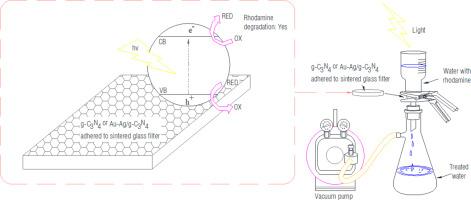烧结玻璃过滤器作为浸渍了 g-C3N4 和 AuAg/g-C3N4 的膜,用于降解罗丹明 B,并将其应用于分散区域
IF 6.3
2区 工程技术
Q1 ENGINEERING, CHEMICAL
引用次数: 0
摘要
这项工作展示了一种新方法,即利用沉积在烧结玻璃过滤器上的石墨氮化碳(g-C3N4)作为增强金银纳米粒子的膜,来去除新出现的污染物。g-C3N4 是通过简单的气相沉积法直接合成在膜表面的。两种不同孔隙率的膜、g-C3N4 和贵金属纳米颗粒通过光催化降解罗丹明 B 染料(RhB)的能力进行了测试。对催化剂的分析采用了傅立叶变换红外光谱(FT-IR)、聚光光谱(PL)、扫描电子显微镜(SEM)、电子发射光谱(EDX)和 DRS 表征技术。在静态(即培养皿)和动态(即光催化膜装置)条件下对 RhB 降解进行了测试。在动态条件下,对最具全面应用潜力的膜的过滤量、浊度效应和稳定性进行了测试。结果证实了催化剂高效的 RhB 降解能力,突出了这种拟议装置的潜力;然而,分散地区的技术成本仍然是一个障碍。这些发现不仅有助于加深对污染物去除技术的理解,还为今后更大规模地部署此类系统提供了实用的见解。本文章由计算机程序翻译,如有差异,请以英文原文为准。

Sintered glass filter as a membrane impregnated with g-C3N4 and AuAg/g-C3N4 to degrade Rhodamine B with application in decentralized areas
This work shows a novel approach utilizing graphitic carbon nitride (g-C3N4) deposited on a sintered glass filter as a membrane enhanced with gold-silver nanoparticles for the removal of emerging pollutants. g-C3N4 was synthesized directly onto the membrane surface with a simple vapor deposition method. Membranes with two different porosities, g-C3N4 and the noble-metal nanoparticles were put to the test by exploring their photocatalytic capacity to degrade rhodamine B dye (RhB). FT-IR, PL, SEM, EDX and DRS characterization techniques were performed to analyse the catalysts. RhB degradation was tested in static (i.e. petri dish) and dynamic conditions (i.e. photocatalytic membrane setup). Filtered volumes, turbidity effect and stability were tested in dynamic conditions for the membrane that had the greatest potential for full-scale use. The results confirm the efficient RhB degradation capacity of the catalysts, highlighting the potential of this proposed setup; however, the cost of technology for decentralized areas is still an impediment. These findings not only contribute to advancing the understanding of pollutant removal technologies, but also, offer practical insights into the future deployment of such systems on a larger scale.
求助全文
通过发布文献求助,成功后即可免费获取论文全文。
去求助
来源期刊

Journal of water process engineering
Biochemistry, Genetics and Molecular Biology-Biotechnology
CiteScore
10.70
自引率
8.60%
发文量
846
审稿时长
24 days
期刊介绍:
The Journal of Water Process Engineering aims to publish refereed, high-quality research papers with significant novelty and impact in all areas of the engineering of water and wastewater processing . Papers on advanced and novel treatment processes and technologies are particularly welcome. The Journal considers papers in areas such as nanotechnology and biotechnology applications in water, novel oxidation and separation processes, membrane processes (except those for desalination) , catalytic processes for the removal of water contaminants, sustainable processes, water reuse and recycling, water use and wastewater minimization, integrated/hybrid technology, process modeling of water treatment and novel treatment processes. Submissions on the subject of adsorbents, including standard measurements of adsorption kinetics and equilibrium will only be considered if there is a genuine case for novelty and contribution, for example highly novel, sustainable adsorbents and their use: papers on activated carbon-type materials derived from natural matter, or surfactant-modified clays and related minerals, would not fulfil this criterion. The Journal particularly welcomes contributions involving environmentally, economically and socially sustainable technology for water treatment, including those which are energy-efficient, with minimal or no chemical consumption, and capable of water recycling and reuse that minimizes the direct disposal of wastewater to the aquatic environment. Papers that describe novel ideas for solving issues related to water quality and availability are also welcome, as are those that show the transfer of techniques from other disciplines. The Journal will consider papers dealing with processes for various water matrices including drinking water (except desalination), domestic, urban and industrial wastewaters, in addition to their residues. It is expected that the journal will be of particular relevance to chemical and process engineers working in the field. The Journal welcomes Full Text papers, Short Communications, State-of-the-Art Reviews and Letters to Editors and Case Studies
 求助内容:
求助内容: 应助结果提醒方式:
应助结果提醒方式:


